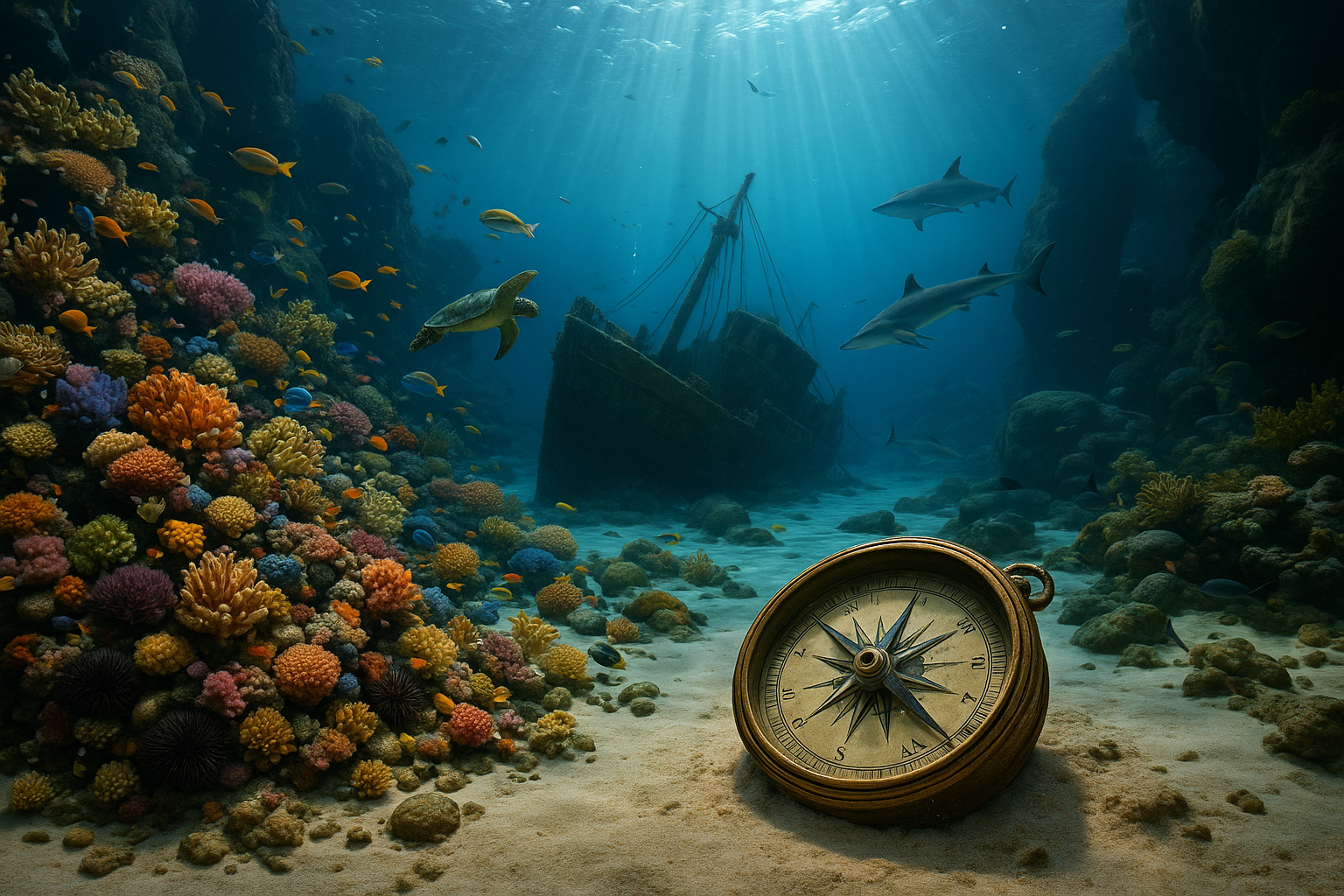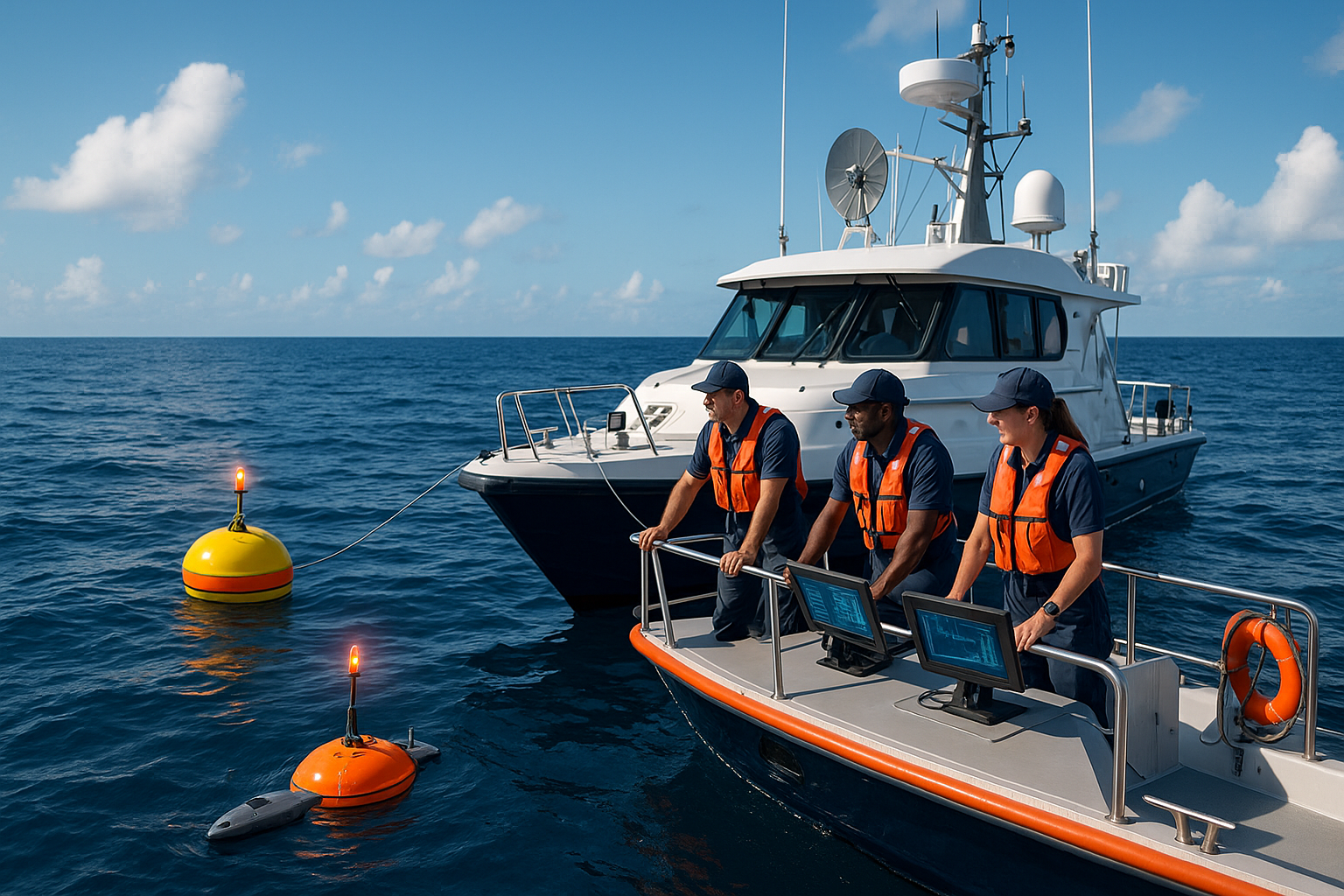In the silent embrace of the ocean’s depths, a vibrant and mysterious world unfolds, full of enchanting sights and hidden wonders. For those of us who dare to venture beneath the waves, the sea offers a unique blend of beauty and intrigue, where every dive is an exploration of the unknown. This article invites you on a journey to discover the marvels of undersea landmarks, focusing on how these natural and man-made features have become vital navigation points for marine explorers. 🌊
From the mesmerizing coral gardens of the Great Barrier Reef to the ghostly remains of shipwrecks scattered across the ocean floor, undersea landmarks serve as critical reference points for divers and marine navigators. These landmarks are not just physical markers; they are stories frozen in time, waiting to be uncovered by those brave enough to seek them. In the world of marine navigation, these points are essential for charting courses, ensuring safety, and understanding the underwater topography that shapes our oceans.
Have you ever wondered how early sailors managed to navigate vast, open waters without the advanced technology we have today? The answer lies in the strategic use of natural undersea landmarks, which have guided seafarers for centuries. As we dive deeper into this topic, we’ll explore how these landmarks have been historically significant and how modern technology continues to evolve in mapping and navigating the ocean’s depths.
The journey begins with a look at the types of undersea landmarks that captivate both professional divers and curious explorers. Coral reefs, with their vibrant colors and bustling marine life, not only provide breathtaking views but also serve as crucial ecological hubs. These living structures offer vital clues for navigation and are often the first indicators of nearby land. Similarly, underwater mountain ranges, or seamounts, rise dramatically from the ocean floor, creating unique ecosystems and acting as navigational aids.
Our exploration will also take us to the eerie beauty of shipwrecks, which lie scattered across the ocean like forgotten time capsules. These remnants of human endeavor tell tales of adventure and tragedy, serving as poignant reminders of the ocean’s power. As artificial reefs, they now support diverse marine life, becoming integral parts of the undersea landscape and valuable navigation points.
In the modern age, technology has transformed the way we interact with and navigate the ocean. We’ll delve into the advancements in marine mapping and GPS technology, which have made it easier than ever to explore these underwater wonders. Yet, despite these advancements, the fundamental principles of marine navigation remain rooted in the natural landmarks that have guided explorers for generations.
Throughout this exploration, we’ll consider the role of marine conservation and the importance of preserving these vital ecosystems. The health of our oceans is closely linked to the well-being of the planet, and understanding undersea landmarks helps us appreciate the delicate balance within these environments. 🌍
By the end of this article, you will have gained a deeper appreciation for the intricate world of undersea landmarks and the role they play in marine navigation. Whether you’re an experienced diver or simply someone fascinated by the mysteries of the deep, this exploration promises to enlighten and inspire. So, let us embark on this journey together, diving into the heart of the ocean to uncover the secrets that lie beneath the waves.
Upcoming Highlights
As we delve deeper into our exploration, here are some of the fascinating topics we will cover:
- Historical Significance: Discover how ancient mariners relied on natural landmarks for navigation long before modern technology.
- Types of Undersea Landmarks: Explore the diverse range of underwater features, from coral reefs to shipwrecks, and their importance in marine ecosystems.
- Modern Navigation Technology: Learn about the latest advancements in marine mapping and how technology enhances our ability to navigate and understand the ocean.
- Conservation Efforts: Understand the critical role of preserving undersea landmarks for future generations and the planet’s health.
Join us as we dive into the depths and unravel the mysteries of the ocean’s most captivating landmarks. 🌊
# Dive into the Depths: Unveiling the Mysteries of Undersea Landmarks
Marine navigation has fascinated humans for centuries, with the ocean holding secrets that span both time and space. The discovery and exploration of underwater landmarks are pivotal in understanding not only marine biology but also the history and culture of maritime civilizations. These landmarks serve as crucial reference points for navigators, offering a glimpse into the wonders hidden beneath the waves. Join us as we delve into the realm of undersea landmarks, unveiling the mysteries they hold and their significance in marine navigation.
## The Science Behind Underwater Landmarks: Natural and Man-Made Marvels
The ocean’s depths are home to a plethora of natural formations and man-made structures that captivate scientists and explorers alike. Natural landmarks such as coral reefs, seamounts, and hydrothermal vents are not only stunning in their beauty but are also vital ecosystems supporting diverse marine life. Understanding these formations provides insights into oceanic processes and environmental changes. Man-made structures, on the other hand, include shipwrecks and submerged cities that tell tales of past civilizations and historical events.
Natural underwater landmarks are formed through various geological and biological processes. For example, coral reefs develop over thousands of years as tiny marine organisms called polyps secrete calcium carbonate, creating intricate structures that serve as habitats for numerous species. Seamounts, which are underwater mountains formed by volcanic activity, provide unique environments for marine life due to their varied depths and nutrient-rich waters. Hydrothermal vents, found in the deep ocean, are created when seawater interacts with magma, releasing minerals and supporting unique ecosystems that thrive in extreme conditions.
Man-made landmarks, on the other hand, offer a window into human history and technological advancement. Shipwrecks, for instance, are not only archaeological treasures but also serve as artificial reefs, attracting marine life and contributing to biodiversity. Submerged cities and structures provide insights into ancient civilizations, revealing how they adapted to and interacted with their maritime environment. Exploring these sites helps historians and archaeologists piece together historical narratives and understand the cultural significance of maritime activities.
| Natural Landmarks | Man-Made Landmarks |
|---|---|
| Coral Reefs | Shipwrecks |
| Seamounts | Submerged Cities |
| Hydrothermal Vents | Underwater Archaeological Sites |
## Navigating the Unknown: Techniques and Technologies in Marine Exploration
Marine navigation has evolved significantly, from the early days of celestial navigation to the sophisticated technology used today. Understanding the techniques and technologies employed in exploring undersea landmarks is essential for appreciating the advances made in marine exploration. Modern navigational tools and methods have revolutionized our ability to locate, map, and study underwater features, enhancing our understanding of the ocean and its inhabitants.
Traditional navigation relied heavily on celestial bodies, with sailors using the position of the sun, moon, and stars to determine their location. This method, while effective, was limited by weather conditions and visibility. The advent of the compass and later the chronometer marked significant milestones in navigation, allowing for more accurate positioning and timekeeping. These advancements laid the groundwork for modern navigational techniques.
Today’s marine exploration relies on cutting-edge technologies that enable detailed mapping and analysis of the ocean floor. Sonar, for instance, uses sound waves to detect objects and map the seabed, providing precise measurements and images. Remotely Operated Vehicles (ROVs) and Autonomous Underwater Vehicles (AUVs) are unmanned submersibles equipped with cameras and sensors, allowing researchers to explore and document underwater environments without the limitations of human divers. Satellite imagery and GPS technology have further enhanced our ability to navigate and study the ocean, providing real-time data and accurate positioning.
Watch an insightful video on the advancements in marine navigation techniques: “The Evolution of Marine Navigation” by MarineTech Channel.
## The Ecological Significance of Undersea Landmarks: Guardians of Marine Biodiversity
Undersea landmarks are not just geological wonders; they play a crucial role in maintaining the health and balance of marine ecosystems. These formations provide habitats, breeding grounds, and nurseries for countless marine species, making them vital for biodiversity. Understanding the ecological significance of these landmarks is essential for conservation efforts and sustainable ocean management.
Coral reefs, for example, are often referred to as the “rainforests of the sea” due to their incredible biodiversity. They support an estimated 25% of all marine species, despite covering less than 1% of the ocean floor. Reefs provide food, shelter, and breeding grounds for fish, invertebrates, and marine mammals. The complex structure of coral reefs creates numerous microhabitats, allowing a wide range of species to coexist and thrive.
Seamounts are also biodiversity hotspots, offering unique environments that support specialized species. Their varied topography and nutrient-rich waters create conditions that favor the growth of diverse marine communities. Seamounts serve as migratory paths and feeding grounds for many oceanic species, including commercially important fish. Protecting these areas is crucial for sustaining fish populations and maintaining the health of marine ecosystems.
Hydrothermal vents, although less known, are vital for studying life in extreme environments. The unique conditions found at these sites, such as high temperatures and pressures, support organisms that have adapted to thrive in seemingly inhospitable conditions. Research on hydrothermal vent ecosystems provides insights into the limits of life on Earth and the potential for life on other planets.
- Coral Reefs: Biodiversity hubs supporting numerous marine species.
- Seamounts: Unique environments fostering specialized species.
- Hydrothermal Vents: Insight into life in extreme conditions.
## Preservation and Conservation: Protecting Our Oceanic Heritage
As human activities continue to impact the ocean, the preservation and conservation of undersea landmarks have become increasingly important. These landmarks are not only valuable for their ecological significance but also for their cultural and historical importance. Efforts to protect and conserve these areas are vital for ensuring the health of our oceans and preserving our maritime heritage for future generations.
Human activities such as overfishing, pollution, and climate change pose significant threats to undersea landmarks. Overfishing can lead to the depletion of species that rely on these habitats, disrupting ecological balance. Pollution from land-based sources, such as plastic waste and chemical runoff, can harm marine life and degrade habitats. Climate change, through ocean warming and acidification, poses a severe threat to coral reefs and other sensitive ecosystems.
Conservation initiatives and marine protected areas (MPAs) play a crucial role in safeguarding these landmarks. MPAs are designated regions where human activities are regulated to protect marine ecosystems and biodiversity. These areas help maintain ecological balance, support fish populations, and preserve habitats. International cooperation and policy-making are essential for effective conservation efforts, ensuring that our oceanic heritage is preserved for future generations.
For more information on marine conservation efforts, check out the video “Marine Conservation: Protecting Our Oceans” by Ocean Guardians on YouTube.
## Conclusion
Undersea landmarks are treasures of the ocean, holding secrets and wonders that captivate the imagination and drive scientific inquiry. From the vibrant ecosystems of coral reefs to the mysterious depths of seamounts and hydrothermal vents, these landmarks are integral to our understanding of the marine world. Their ecological, historical, and cultural significance underscores the need for continued exploration and conservation efforts. By protecting these vital features, we can ensure the health and vitality of our oceans for generations to come.

Conclusion
## Conclusion
In exploring the wonders of undersea landmarks, we have embarked on a fascinating journey that delves deep into the captivating realm of marine navigation and reference points. This exploration has unveiled the intricate ways in which these submerged features serve as crucial guides for marine life and human endeavors alike. From the remarkable biodiversity thriving around underwater mountains and reefs to the vital role these landmarks play in navigation, the marine world offers an awe-inspiring spectacle of nature’s ingenuity and complexity 🌊.
### Recap of Key Points
Throughout this article, we delved into the multifaceted world of undersea landmarks. We began by understanding the nature of these submerged features, ranging from coral reefs and underwater volcanoes to shipwrecks and artificial reefs. These structures are not only mesmerizing in their beauty but also serve as crucial navigational aids. They are essential for marine life, providing habitats and feeding grounds, thereby supporting biodiversity and ecological balance.
We also explored the human dimension, emphasizing the significance of these landmarks for maritime navigation. Mariners and scientists rely on them for charting courses and conducting oceanographic research. The discussion touched on technological advancements, such as sonar and GPS, which have revolutionized the way we interact with and understand these underwater wonders. These technologies have enhanced our ability to explore the depths, revealing mysteries that were once beyond our reach.
Furthermore, we highlighted the importance of preserving these landmarks. Human activities, such as overfishing, pollution, and climate change, pose significant threats to these ecosystems. Conservation efforts are critical to safeguarding these natural treasures for future generations. By protecting these areas, we ensure the continued provision of ecosystem services that are vital to the health of our planet.
### The Importance of the Topic
The significance of understanding and preserving undersea landmarks cannot be overstated. These structures are not merely geographical features; they are vital components of our planet’s health and our own survival. They contribute to biodiversity, support fisheries, and play a pivotal role in global climate regulation. Moreover, they offer economic opportunities through tourism and sustainable resource management.
As we advance technologically, our ability to explore and map these underwater terrains will only grow, providing us with new insights and opportunities. However, with this increased capability comes the responsibility to act as stewards of the marine environment. Our actions today will determine the legacy we leave for future generations 🌍.
### Call to Action
We encourage you, our readers, to reflect on the wonders of the undersea world and the critical role these landmarks play in our lives. Consider how you can contribute to their preservation, whether through advocacy, supporting conservation initiatives, or simply raising awareness. Every action counts in the collective effort to protect our oceans.
Feel free to share your thoughts in the comments below. What aspects of undersea landmarks fascinate you the most? Have you had personal experiences with marine navigation or exploration? Your insights and experiences enrich our understanding and inspire others to engage with this crucial topic.
Additionally, sharing this article with friends and colleagues can help spread awareness about the importance of these underwater wonders. Together, we can foster a community dedicated to the exploration and conservation of our planet’s incredible marine environments 🐠.
For further reading and research, consider exploring the following resources:
– [National Oceanic and Atmospheric Administration (NOAA) – Ocean Exploration](https://oceanexplorer.noaa.gov/)
– [The Nature Conservancy – Marine Conservation](https://www.nature.org/en-us/what-we-do/our-insights/programs/marine-conservation/)
In conclusion, the exploration of undersea landmarks is not just an academic pursuit; it is a journey that calls us to appreciate, respect, and protect the intricate marine systems that sustain us. Let us embrace this responsibility and inspire others to join in this vital endeavor. Together, we can ensure that the wonders of the undersea world continue to thrive for generations to come 🌊🌿.
Thank you for diving into this exploration with us. We look forward to hearing your thoughts and continuing this journey together.
Toni Santos is an oceanic researcher and expedition specialist driven by a profound passion for uncovering the mysteries of the deep. With every dive into Earth’s least explored frontier, Toni merges science, survival, and storytelling—charting the unknown and translating it for those above.
Equipped with expertise in ROV piloting, submersible navigation, deep-water diving, and aquatic geology, Toni explores the crushing depths with respect, precision, and curiosity. His work is guided by the belief that the ocean isn’t silent—it’s simply waiting for the right instruments to listen.
Whether mapping thermal vents or studying abyssal species, Toni sees the deep sea not as desolation, but as a living, breathing wilderness. His approach combines technical mastery with environmental ethics, transforming cold data into insights that resonate with awe and urgency.
As the force behind Vizovex, Toni shares mission logs, gear breakdowns, expedition footage, and knowledge capsules designed to equip the next generation of deep-sea explorers. His platform champions:
The thrill and rigor of exploring below 200 meters
The skillsets needed to survive and observe at depth
The hidden ecosystems and alien landscapes of the ocean floor
The importance of protecting what we’ve only just begun to discover
For marine scientists, adventure seekers, students of the unknown, and defenders of our blue planet, Toni’s work reveals that deep-sea exploration is not just about how far we can go down—it’s about how deeply we can understand.





